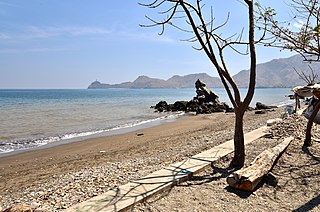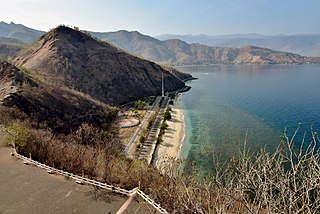
Dili is the capital and largest city of East Timor. It lies on the northern coast of the island of Timor, in a small area of flat land hemmed in by mountains. The climate is tropical, with distinct wet and dry seasons. The city has served as the economic hub and chief port of what is now East Timor since its designation as the capital of Portuguese Timor in 1769. It also serves as the capital of the Dili Municipality, which includes some rural subdivisions in addition to the urban ones that make up the city itself. Dili's growing population is relatively youthful, being mostly of working age. The local language is Tetum; however, residents include many internal migrants from other areas of the country.

Tetum is an Austronesian language spoken on the island of Timor. It is one of the official languages of Timor-Leste and it is also spoken in Belu Regency and in Indonesian West Timor.

East Timor is divided into 14 municipalities, which are former districts. One municipality is also a Special Administrative Region (SAR). The municipalities are divided into administrative posts, and further subdivided into sucos (villages). Atauro Island was initially a part of Dili Municipality, but became a separate municipality on 1 January 2022. The borders between Cova Lima and Ainaro and between Baucau and Viqueque were changed in 2003.

Baucau is a municipality, and was formerly a district, of East Timor, on the northern coast in the eastern part of the country. The capital is also called Baucau. The population of the municipality is 111,694 and it has an area of 1,506 km2.

Atauro, also known as Kambing Island, is an island and municipality of East Timor. Atauro is a small oceanic island situated north of Dili, on the extinct Wetar segment of the volcanic Inner Banda Arc, between the Indonesian islands of Alor and Wetar. The nearest island is the Indonesian island of Liran, 13.0 km (8.1 mi) to the northeast. At the 2015 census, it had 9,274 inhabitants.

Dili Municipality is one of the 14 municipalities, formerly districts, of Timor-Leste, and includes the national capital Dili. The municipality had a population of 277,279 as of 2015, most of whom live in the capital city.

Ombai Strait is an international strait in Southeast Asia. It separates the Alor Archipelago from the islands of Wetar, Atauro, and Timor in the Lesser Sunda Islands. The strait is also the western portion of a pair of international straits, the other one being Wetar Strait; the two straits combine to link the Pacific Ocean with the Indian Ocean.

Wetar Strait is an international strait in Southeast Asia. It separates the island of Wetar from the eastern part of the island of Timor. The strait is also the eastern portion of a pair of international straits, the other one being Ombai Strait; the two straits combine to link the Indian Ocean with the Pacific Ocean.

The Cristo Rei of Dili statue is a 27.0-metre-high (88.6 ft) colossal statue of Jesus Christ situated atop a globe at Cape Fatucama in Dili, East Timor. It is one of East Timor's main tourist attractions.

Tasitolu is a protected area on the coast of East Timor, 8 kilometres (5.0 mi) west of the capital Dili. The Tasitolu wetlands include three saline lakes, an esplanade, and a beach; it has been designated a Wetland of National Significance. Tasitolu Peace Park was designated in 2002 because of its cultural and historical importance. The Tasitolu Important Bird Area accommodates several near-threatened species. A 2004 reforestation project, which included community member participation, was funded by the national government. Subsequent to the 2006 East Timorese crisis, several hundred people sought refuge at Tasitolu's tent camp, established by the United Nations High Commissioner for Refugees. INTERFET, an Australian-led international military Peace Keeping Force governed by the United Nations, has established a base at Tasitolu.

Areia Branca no Dolok Oan is a 2,916 ha Important Bird Area (IBA) in East Timor, a country occupying the eastern end of the island of Timor at the eastern end of the Lesser Sunda Islands group of Wallacea.

The Berloi Waterfall is a small waterfall in the municipality of Aileu, East Timor. It forms part of a minor tributary of the Comoro River.

The Bay of Dili is a bay on the north coast of East Timor adjacent to Dili, its capital city. The bay forms part of Ombai Strait, which separates the Alor Archipelago from the islands of Wetar, Atauro, and Timor in the Lesser Sunda Islands.

Bidau Santana is a suco in Cristo Rei Administrative Post, Dili Municipality, East Timor. The administrative area covers an area of 1.84 square kilometres and at the time of the 2015 census it had a population of 6,482 people.

Cristo Rei Beach is a public beach facing the Bay of Dili in the suco of Metiaut, East Timor.

Dolok Oan, also known in English as Cristo Rei Back Beach or Jesus Backside Beach, is a public beach located in the suco of Hera, a short distance northeast of Dili, East Timor. The beach forms part of the south shore of Wetar Strait, immediately to the east of Cape Fatucama.

Areia Branca Beach is a public beach on the north eastern shore of the Bay of Dili, in the suco of Metiaut, East Timor. It is very popular with both local residents and tourists.

One Dollar Beach or Dollar Beach is a public beach on the north coast of East Timor, east north east of Dili, the capital city. It is long, white, sandy and clean, and also frequently deserted, yet popular with beach users at other times.

Valu Beach is a public beach at the easternmost tip of mainland East Timor, and the gateway to Jaco Island to its east.




















